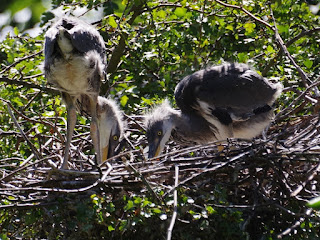Here they are at the island. That makes six families in the park.
Another brood of seven slightly larger Tufted ducklings were busy collecting food from the bottom of the lake.
Young Egyptian Geese tend to sprawl rather than sit neatly. These two are stretching their newly developed wings.
Probably they are already flying. Jorgen reported having seen the family of Canadas with 15 goslings (including an accidentally adopted Greylag) all flying together, including the youngest Canada (another adoption) which you would not have thought was ready yet.
This family of Mute Swans has edged under the bridge into the territory of the dominant pair who keep the Long Water for themselves. The bank next to the bridge is a sheltered place where the dominant male can't easily attack them.
We haven't had a picture for a while of the two Great Crested Grebe chicks at the reed bed at the north end of the Long Water. Altogther there are eleven chicks on both lakes.
A young Moorhen at Peter Pan is developing the red and yellow bill and the yellow-green legs of an adult.
The young Grey Herons on the island are also growing up fast. One stretched its wings, showing well grown primaries still mostly enclosed in their wrappings.
The female Kestrel was hunting on Buck Hill. I didn't see the male.
No day is complete without a sight of a Little Owl at the leaf yard.
Usually the songbirds fall silent at the end of June, but this Blackbird is still singing a month later. He is the mate of the white-faced Blackbird near the Italian Garden. You can hear the fountains in the background.
One of the pair of Coal Tits at the bridge came down to take a pine nut.
Some Long-Tailed Tits were hunting insects in trees near the Queen's Temple.
This is as close as I could get the camera to a male Red-Tailed Bumblebee as he busied himself drinking nectar from the many florets on a sunflower. The flower was moving gently in the breeze.
























































